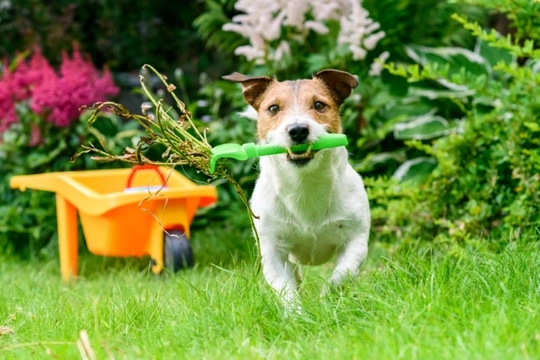
Five poisons that might be lurking in your dog’s garden in summer
Most of us that have a garden find it very useful to use to allow the dog out to do their business, and of course, to provide them with a safe, enclosed space to play and exercise. However, there are a number of potential poisons that can be lurking in the garden that are all too easy to overlook, but that could be acutely dangerous to your dog.
This article will tell you about five summer-specific poisons and toxins that might be lurking in your dog’s garden. Read on to learn more.
Toads
Toads! Toads are toxic to dogs, and you’re most likely to see toads in your garden and in the places you usually walk your dog (depending on habitat) from June to August, which is spawning season. Toads tend to return to the same places each year to spawn, so if you know where this has happened in years gone by, there’s a reasonable chance these same places will be absolutely carpeted with toads again when they’re ready to spawn.
Toads tend to dwell around the shores of fresh water with little to now flow, like ponds, lakes, and marshes. They also commonly set up home in garden ponds too, particularly those that aren’t used.
There are two toad species found in the UK, being the natterjack toad and the common toad. You’re far more likely to spot common toads than natterjack toads in your garden, the latter being far rarer (and is actually a protected species) and largely limited in geographical range to England’s north west and the east Anglia region.
Telling the difference between the two toad species isn’t strictly relevant for the purposes of this article, however, as both types of toads are toxic to dogs. The toad’s skin secretes a toxic substance when they feel threatened and to deter predators; which is exactly how your dog will seem if it finds a toad and paws at it or tries to pick a toad up in its mouth
If your dog does come into contact with a toad, rinse their mouth out and contact your vet for advice. If you do have toads in your garden, you will need to supervise your dog when in the garden, and even potentially keep them on a lead to prevent contact.
Cocoa mulch and shells
Cocoa mulch and cocoa shells are waste by-products from the cocoa bean. Cocoa beans are of course what chocolate is made from – and all dog owners know that chocolate is toxic to dogs. In fact, it is actually cocoa itself – or rather a compound within it called theobromine – that makes chocolate toxic to dogs.
But why would cocoa be around in the garden? Well, both cocoa mulch and cocoa husks or shells are actually sold to gardeners as an organic way to control weed growth naturally, without the use of pesticides. However, even though this is better for the environment, it does mean that both cocoa mulch and cocoa shells are toxic to dogs.
Metaldehyde pest pellets
Metaldehyde is a type of pesticide used in slug and snail pellets to kill garden pests, and this is one of the most common garden hazards to dogs. Blue slug pellets and other products in this family that contain metaldehydes can be just as dangerous to your dog as they are to the slugs and snails they are designed to eradicate, and so should not be used in a garden a dog also has access to.
Metaldehyde poisoning in dogs can be fatal, and is quite complex and often very expensive to treat.
Ant powder
Ant powder or ant bait, which can be found in bait stations, gels, and granules, are all toxic to dogs. If you find that ants keep coming into the home from your garden or anthills are messing up your flowerbeds, you might be considering products of these types around your doorsteps or in the garden to help to eradicate the ants at source.
However, all of these things are toxic to dogs; although to what extent can be really variable. Some ant powders can poison a dog from just a very small amount and may prove fatal. Others are apt to cause a digestive upset that is transient and mild.
It is a good idea to play it safe either way, and only use products to kill or deter ants that are pet-safe, if your dog has access to your garden.
Certain summer flowers
Just as how there are a number of fruits and vegetables that are toxic to dogs, so too are some of the flowers that you may wish to grow in your garden poisonous to dogs too. Before you plant anything new in a garden a dog has access to, it is wise to check it against a list of flowers that are toxic to dogs.
You can then weigh up the risks in terms of how toxic it is, and how likely it is that your dog would be exposed to it; for instance, a dog that digs up flower beds and that may pick out flower bulbs is likely to be a hazard to themselves in this context!
Some of the most common summer flowers that are toxic to dogs include chrysanthemums, daffodils, and foxgloves, so steer clear of these if your dog might be a problem.



